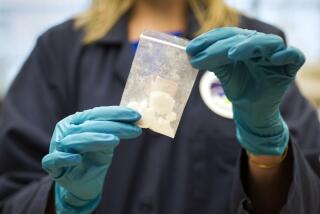SCIENCE, OZONE LAYER : Chemicals Still Stratospheric Problem, Expert Says
- Share via
IRVINE — Chemicals that are eating a hole in the Earth’s protective ozone layer are still being released into the air at record levels despite international agreements to phase out their use, a world-renowned University of California chemist said Monday.
F. Sherwood Rowland, the UC Irvine scientist who discovered the link between chlorofluorocarbons (CFCs) and the ozone layer 17 years ago, released the results of tests that show emission of the chemicals reached a record high this year and are growing.
“The striking thing is that we haven’t seen the fall-off yet,” Rowland said. “We thought by now we’d see a little downturn, but we haven’t. The announced cutbacks so far haven’t shown up in the atmosphere.”
Rowland has predicted that a slight drop might occur next year, but he warned that the worst is yet to come for the expanding hole in the ozone shield because of the delayed reaction of the chemicals. The hole in the layer--which protects Earth from harmful ultraviolet radiation--is expected to continue to expand until at least 2010, even if controls now in place are effective.
The world’s major industrialized nations agreed in the 1987 Montreal Protocol to cut use of CFCs in half by the end of the century. In June, they refined the pact by agreeing to cut use by 20% by 1993, and 50% by 1995, eliminating them by 2000.
Also, Dupont and Allied-Signal, the two largest U.S. producers of the chemicals, have said they will stop manufacturing them by then. The chemicals are used mainly as industrial cleaning solvents and as cooling agents in refrigerators and car air conditioners.
Despite those announcements, Rowland said, the last five years have been the worst in history when it comes to the increase in CFCs entering the atmosphere.
Rowland and his research team have been collecting air samples at remote sites over the Pacific Ocean from Alaska to New Zealand since 1978. The most recent report, which compares results at more than 60 sites through June, 1990, was presented Monday at an annual conference of the American Geophysical Union in San Francisco.
CFCs release chlorine that moves up in the stratosphere and destroys ozone. The resulting increased penetration of ultraviolet radiation can lead to skin cancer and cataracts. Scientists also believe CFCs can cause global warming, increase smog, and endanger ecosystems.
An increasingly major source of the problem is CFC 113, a solvent still used widely by industry to clean electronic parts, according to Rowland’s report. Manufacturers have said they know of no low-polluting substitute for the chemical in most of their metal-cleaning operations.
Use of the industrial chemical in 1988 was about three times greater than in 1976, according to Rowland’s data. It is now about equal to emissions from the two other major CFCs that are used mostly in air conditioners and refrigerators and as blowing agents during the manufacture of foam and polystyrene.
In the four-county Los Angeles basin, about 7,000 tons of CFCs are released into the air a year, with the largest sources industrial plants using them as cleaning solvents, according to a recent report by the South Coast Air Quality Management District.
Rowland said that even with a downturn next year, he and other scientists are concerned that the hole in the ozone layer over Antarctica will continue to grow rapidly because CFCs can take 10 years after they are released into the air to reach their maximum ozone-destroying potential. The compounds have a life of at least 60 years, with some lasting over 100 years.






